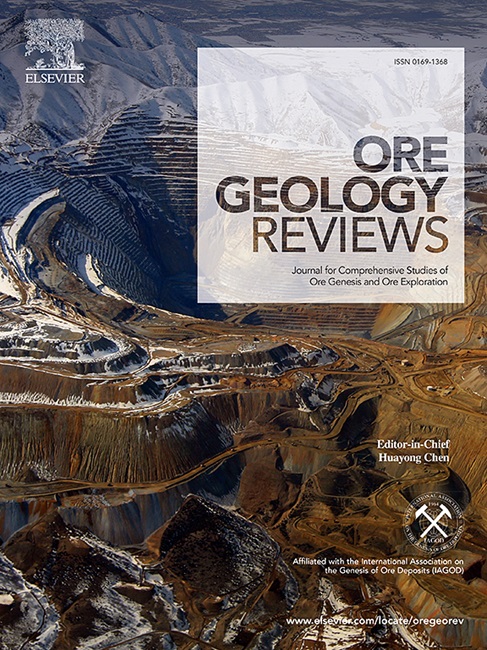The geochemistry, origins and metallurgical implications of different textural types of spodumene-quartz intergrowths (SQUI) from the Tanco pegmatite, Manitoba, Canada
IF 3.2
2区 地球科学
Q1 GEOLOGY
引用次数: 0
Abstract
The Archean Tanco deposit in southeastern Manitoba is a complexly zoned petalite-subtype pegmatite. Lithium mineralization primarily occurs as spodumene-quartz intergrowths (SQUI), which are historically interpreted as pseudomorphs of petalite breakdown. This breakdown would produce a spodumene-to-quartz ratio of 56.3:43.7 vol%, volume reduction textures, and low trace element contents. However, SQUI at Tanco shows variable spodumene-to-quartz ratios, remarkably little petalite preservation or volume reduction textures and green spodumene with up to 8330 ppm Fe.
Three textural varieties of spodumene-quartz associations were identified and described in zones 45 and 50 of the pegmatite: (1) Classic SQUI with c-axis-oriented, oscillatory-zoned spodumene and quartz, which locally occur within relict crystal outlines; (2) spodumene-quartz symplectites (SQS) characterized by pervasive symplectic intergrowths with elevated Cs and depleted Mn and Sn; and (3) macro spodumene-quartz intergrowths with randomly oriented, stubby crystals and chaotic zonation.
Metastable virgilite exists as a solid solution with quartz and is known to crystallize from experimental pegmatite crystallization studies. The breakdown of virgilite into classic SQUI could explain the lack of petalite and volume reduction textures, variable mineralogical ratios, and iron-bearing spodumene in SQUI. SQS likely resulted from coupled dissolution-reprecipitation in the presence of a fluid, while macro intergrowths represent primary magmatic textures. The occurrence of SQS at Tanco poses a metallurgical issue due to the fine sizes and hardness of the intergrowths leading to Li recovery issues. Understanding the origins of lithium mineralization is important as the quartz-spodumene textural associations have metallurgical recovery implications, affecting the overall economic viability of deposits.

加拿大坦科伟晶岩中不同结构类型锂辉石-石英互生体的地球化学、成因及冶金意义
曼尼托巴东南部的太古代Tanco矿床是一个复杂分带的伟晶岩亚型。锂矿化主要以锂辉石-石英互生体(SQUI)的形式发生,历史上被解释为辉石碎裂的伪晶。这一分解过程产生的锂辉石与石英的体积比为56.3:43.7 vol%,结构体积减小,微量元素含量低。然而,Tanco的SQUI显示出可变的锂辉石与石英的比例,非常少的petalite保存或体积缩小纹理和高达8330 ppm Fe的绿色锂辉石。在伟晶岩45区和50区,发现并描述了三种锂辉石-石英组合的结构变化:(1)典型的SQUI,具有c轴取向、振荡带的锂辉石和石英,局部分布在残余晶体轮廓内;(2)锂辉石-石英共长石(SQS),其特征为Cs升高,Mn和Sn贫化;(3)宏观锂辉石-石英互生,取向随机,晶体粗短,分带混乱。亚稳virgilite以与石英的固溶体形式存在,并且从实验伟晶岩结晶研究中知道它会结晶。virgilite分解成典型的SQUI可以解释SQUI中缺乏瓣长石和体积缩小结构、可变矿物学比和含铁锂辉石的原因。在流体存在的情况下,SQS可能是溶蚀-再沉淀耦合作用的结果,而宏观共生则代表了原始岩浆结构。由于共生体的细尺寸和硬度导致Li回收问题,在Tanco发生SQS带来了冶金问题。了解锂矿化的起源非常重要,因为石英-锂辉石结构组合具有冶金回收意义,影响矿床的整体经济可行性。
本文章由计算机程序翻译,如有差异,请以英文原文为准。
求助全文
约1分钟内获得全文
求助全文
来源期刊

Ore Geology Reviews
地学-地质学
CiteScore
6.50
自引率
27.30%
发文量
546
审稿时长
22.9 weeks
期刊介绍:
Ore Geology Reviews aims to familiarize all earth scientists with recent advances in a number of interconnected disciplines related to the study of, and search for, ore deposits. The reviews range from brief to longer contributions, but the journal preferentially publishes manuscripts that fill the niche between the commonly shorter journal articles and the comprehensive book coverages, and thus has a special appeal to many authors and readers.
 求助内容:
求助内容: 应助结果提醒方式:
应助结果提醒方式:


